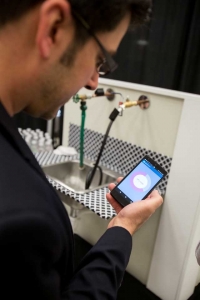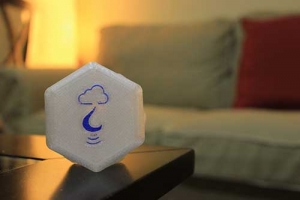Two teams from BioE received top honors at April’s UW Foster School of Business 2015 Alaska Airlines Environmental Innovation Challenge. The competition challenges interdisciplinary student teams to identify and propose solutions to environmental problems, develop business plans that prove market potential, and pitch their ideas to judges at a demo-day event. This year, 36 teams proposed innovations in clean technology, renewable energy and water resource management.
 Hook makes home automation simple
Hook makes home automation simple
Hook, a team led by Rahil Jain, a Ph.D. student in electrical engineering and research associate in the lab of Barry Lutz, assistant professor of bioengineering, received the competition’s second place $10,000 prize. Rahil’s team members include Maxwell Wheeler, a research scientist in bioengineering, Anigo, a professional software developer, and Robert Moehle, a student in Foster’s Technology Management MBA program.
Hook is a home automation hub that provides an easy, affordable way to convert one’s cell phone into a smart home remote control. “We want to make consumers’ lives simple,” Rahil explains. “With Hook we want to put the Internet to work for them and take care of basic things in life.”
Consumers can already simplify the operation of electronics throughout the home by purchasing affordable remote-controllable outlet adapters. Let’s say you wanted to turn off all the lights in your home at the end of a long day – without getting out of bed. Just install a few simple outlet adapters throughout your home, and then you’d be able to switch off the lights with the press of a button on a remote control. However, the outlets only work within the range of the remote – you might not be able to turn off the kitchen lights off from your bedroom upstairs. The outlets also have limited functionality – you can’t program them to automatically shut the lights off at a specific time each night. Fully programmable, automated solutions can be very expensive and complicated to set up.
Hook enables affordable, simple home automation by turning those remote-controllable outlets into “smart” devices. Hook connects remote controlled outlets, light bulb sockets, motorized blinds and more to the internet and enables their operation from a smart phone. Using the above example, you could launch the Hook app on your phone to program the lights in your home to shut off at 10:00 p.m. weeknights – and perhaps just a bit later on weekends. If you’re a tinkerer or hacker, you can take Hook’s capabilities even further via its open-access API.
The team Hook’s automation capabilities not only provides consumers with convenience but also energy consumption savings, increased safety in their homes and enhanced functionality of older electronic devices that might otherwise end up in landfills. The team launched Hook on Kickstarter in April, and and is currently headed into the final round of this quarter’s UW Business Plan Competition.
Looking forward, Rahil explains that Hook is just the beginning of a series of consumer electronics his team wants to bring to market. “Our vision is to make existing dumb things smart, so that you don’t have to buy new and ditch the ones you love,” he says. “If you’ve always wanted a WiFi bathroom scale but hate to get rid of the one you already have, that’s where we come in.”

EcoStream offers consumers fun, easy ways to monitor their water usage
EcoStream builds awareness, lifelong habits by making water conservation fun, easy
EcoStream, led by BioE Ph.D. candidate Shon Schmidt, received the competition’s $2,500 honorable mention prize. Other team members include BioE research scientist/engineer Josh Bishop, Ryan Osher and Michaela Byrne, both Foster MBA students, Vince Wu and Jon Han who are UW EE undergrads, and Jon Dankworth, a CPA who double majored in business administration and accounting.
EcoStream aims to build awareness and lifelong habits to conserve our most valuable resource, water. The majority of U.S. households are unaware of how much water they consume each day. This lack of awareness contributes to over-consumption and poor management of water use by consumers and public utility companies alike. It’s also making water more expensive – the cost of water has increased 33 percent in just the last five years.
More importantly, the over-use of water is worsening the severe drought currently experienced by many areas of the country. 27 percent of the U.S. is currently in drought, with seven states running out of water (California, Nevada, New Mexico, Kansas, Arizona, Oklahoma and Texas). California’s drought is particularly troubling, since it is the U.S.’s most populous state but also has more national parks than any other state and is the world’s eighth largest economy.
The EcoStream team believes that if all U.S. households more aware of their water usage, overall water consumption would decrease by 30 percent or more, saving money and the environment. By using EcoStream, households could save up to $300 per year on water utility costs and in the seven states most impacted by drought alone, the total savings could equal approximately $93 million dollars. Across the nation, savings could approach $35 billion.
The EcoStream system is an affordable wireless sensing technology that enables consumers to monitor their use of a home utility – in this case, water – and achieve cost savings in an easy and fun way. The system works via sensors that are attached sinks, showers, dishwashers, washing machines and other everyday appliances that use water. The sensors connect to the Internet and compile real-time information about water use. The system sends the user real-time alerts on their smartphone. Using their smartphone, the user can access easy-to-understand graphs and statistics to strategize how to optimize water usage, save costs and reduce environmental impact. EcoStream even offers users a forum for interacting with each other and participating in activities aimed at making water conservation fun and easy.
In addition to helping consumers save money via water conservation, EcoStream offers the added benefit – and peace of mind – of notifying a homeowner when a water pipe breaks. This feature reduces the liability of water damage and helps homeowners and insurance companies achieve cost savings through reduced premiums.
The team has established a working proof-of-concept and evaluated the market for the product. The team is currently seeking $15K to build 10 prototype systems to further refine the technology and user experience. The investment will also help the team secure protection for their sensor fusion technology for water monitoring.
They plan to target California Water Service Group, a major water utility serving customers and 100 communities throughout the western U.S., as their first customer. The team hopes that a successful launch with this utility will make expansion throughout the rest of the country more promising.


 Hook makes home automation simple
Hook makes home automation simple